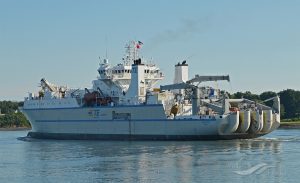We had a fantastic talk about international communications from the speaker’s own perspective as a technical programme manager for a major multinational company which is responsible for large proportion of global internet traffic. Rob heads the company’s data centre internationally. After Tapton school and a degree from Salford University, he worked for BT Global Services, Bovis (as part of the team developing Meadowhall and the Manchester Arena) and, more recently, as IT Director for pharmaceutical company Wyeth before moving to California. A real Sheffield success story!
The first transatlantic submarine telephone cable was laid in 1858 but it was a century later before a connection was established across the Pacific. The world’s first telegram was sent by Queen Victoria to the USA president in 1868. The difference now is a fibre optic cable replacing the 19th century copper core insulated by a fat sealant, reinforced and made watertight at great depth by steel, hessian and tar.

Submarine cables are preferred to satellite for telecommunications because of far greater transmission speeds (100ms latency) and the need for two-way traffic. Sky, on the other hand, needs just one-way traffic for global TV transmission, and satellite is ideal. The 600ms latency for TV doesn’t matter. Light travels very fast through glass (100ms across the Atlantic through fibre optic cable) and is ten times quicker than by satellite, where much greater distances through space are involved. Bandwidth denotes capacity (think of the impact the number of motorway lanes has on traffic flow).
Internet traffic is growing by 2 per cent per annum and will have doubled by 2021. At present 4.3 million YouTube videos, and nearly 4m WhatsApp messages shoot round the globe every minute of the day! Extra capacity is needed (and being planned) for 50 per cent of the rest of the world not yet connected to the internet (perhaps worrying when you think how ancient cultures were changed for ever once “civilisation” intruded … Tahitians, Sub-Saharan Africans, Aborigines, Indigenous Americans etc, etc).
There are numerous constraints to laying underwater cables; hostile weather, deep salt water up to 9,000 metres, fishing, wildlife, mountainous sea beds, tectonic plate shift and shark bites (even attacking cables). High tech survey ships gauge the depth, topography, slope, angles, sea bed type and then cable routes are established. The need for occasional retrieval for repair adds to the level of engineering expertise required. There are 45 cable-laying ships globally and owned by Tyco (who incidentally in my time were also manufacturers of surgical stapling devices very familiar to your blogger, and which will have fired multiple staples into at least one or two of our Probus members’ innards). Some 100 pans of cables are in the hold of the cable ship, taking about a month to load, but sufficient to allow complete laying over a single voyage. At $80,000 a day (millennium prices) the expense of running cable ships is enormous. Ploughs dragged behind the ship cut trenches into the sea bed into which cables are protected in places where they would be vulnerable if left exposed, particularly close to shore.
Ships carry a remote vehicle which can descend to 2,500 metres either to repair cable on the sea bed or retrieve the affected segment for repair while elevated and suspended by a series of buoys. Ships are very manoeuvrable so they can cope with precision cable lifting and laying, particularly in adverse conditions. Nearby ships are warned to stay a mile clear to avoid collision with the cables as they are lifted.
Some 10 or 11 cable stations (BMHs) are dotted around the UK coastline where beaches are gently sloping, and under constant surveillance. At 50-metres intervals along the cable are amplifiers. These are powered with several thousand Kv running through insulated copper cables incorporated into the fibre optic assembly. The joints are vulnerable to damage. We saw a cross-sectional example of a typical fibre optic cable and watched several excellent videos of its manufacture Cable is ‘armoured’ where it is exposed to heavy shipping, such as in the Suez Canal. Cable positioning is intricate, particularly near the shore, where the ship needs to anchor while the cable is lowered. Laying speeds are variable: 0.2km/hr (expensive) for armoured segments when divers are in the water and up to 8km/hr (cheaper) when automated in open water.
A key stakeholder is the fishing industry. Mutual co-operation is advantageous to both. Fishing boats are used for surveys in their own locality, which is lucrative for the fishermen, and cables can be sited away from their fishing grounds, thereby lowering the risk of snagging by abandoned fishing gear and anchors cut free in bad weather or from dredging. Most of the risks are close to shore from fishing (75 per cent), dredging, and anchors. Seismic activity accounts for five per cent. A damaged cable drifting away can be located by voltage shift and its position is constantly surveyed. Cables get bitten by sharks, and we had an amazing video demonstration of this. The latest generation of cables are privately and often jointly owned, due to enormous capital costs involved. Cables fail after 20 or 25 years due to obsolescence, repairs or the hostility of the environment.
